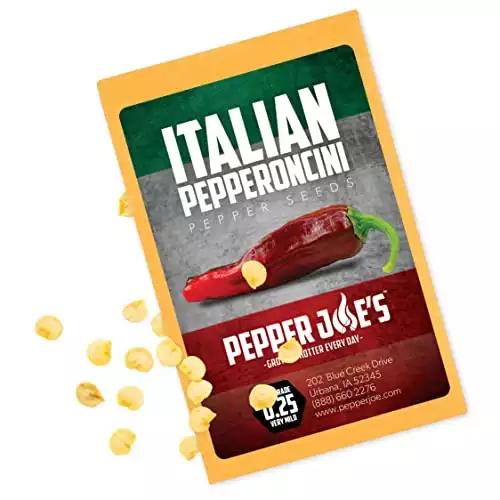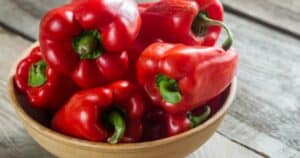Have you ever wondered about those bright red, horn-shaped peppers that give Italian food its signature
You may be concerned that peperoncino peppers will set your mouth on fire. Not to worry! While packing a pleasant punch, these chilis register only 100-500 Scoville heat units – milder than a jalapeño. Their brightness adds warmth without overpowering the flavor of your dish.
The peperoncino is a small, herbaceous plant with lance-shaped green leaves and tiny white flowers. You’ll be delighted to know that peperoncino thrives easily in home gardens and containers with full sun exposure.
This versatile Italian pepper stars in many iconic dishes like pasta sauces, antipasti spreads, seafood dishes, and more. Its fruity, slightly bitter flavor varies by cultivar – from the ultra-spicy Pequin to mild, sweet Peppadew.
You’ll also be glad to hear that peperoncino is easy to preserve by pickling, freezing, drying, or jarring. Follow some simple storage tips to enjoy their zing year-round.
Now that you know peperoncino won’t set your tastebuds aflame, you can confidently add its brightness to your cooking. Keep reading this article to learn step-by-step growing information, harvesting techniques, recipe inspiration, and much more about this incredible Italian staple. Discover how to
An Introduction to the Peperoncino

The peperoncino (also known as peperoncini) is a type of hot chili pepper native to Central America. Its scientific name is Capsicum annuum. This herbaceous plant produces dark green, lance-shaped leaves and tiny white flowers.
Key Facts About the Peperoncino:
- Appearance: Peperoncino plants are bushy and grow 1-3 feet tall. The smooth, slender peppers start out green and ripen to vivid red.
- Heat Level: Ranging from 100-500 on the Scoville scale, peperoncino brings moderately spicy heat.
- Flavor: Notes of bitterness, fruitiness, and freshness.
- Uses: This versatile pepper stars in Italian pasta, pizza, antipasti, and more.
- Growing: Thrives in warm climates with full sun. Does well in containers.
Now that you know the basics, let’s take a delicious deep dive into all things peperoncino!
Growing Peperoncino Peppers
Adding some homegrown peperoncino to your recipes is simple and rewarding. Here are some top tips:
- Start seeds indoors 6-8 weeks before your last expected frost date. Peppers need warm soil (at least 65°F) to germinate.
- Transplant seedlings outside after all danger of frost has passed. Space plants 18-24 inches apart in well-draining soil.
- Soak up the sunshine. Peperoncino thrives in full sun – at least 6 hours per day.
- Water regularly. Give plants about an inch of water per week, allowing soil to dry slightly between waterings.
- Fertilize occasionally. Use a balanced liquid fertilizer every 2-3 weeks during the growing season.
- Watch for pests. Aphids, cutworms, and pepper weevils can attack. Remove by hand or use insecticidal soap.
With proper care, you’ll be harvesting an abundant crop of peperoncino peppers in no time!
Pack of 10+ Mild Chili Pepper Seeds – USA Grown – Premium Non-GMO Red Pepperoncini Seeds for Planting
Cooking with Peperoncino Peppers
Versatile, flavorful peperoncino peppers liven up pasta, seafood, meat, and more. Here are some delicious ways to put them to work:
Pasta Sauces
Peperoncino packs traditional Italian pasta sauces like arrabbiata and puttanesca with bright, spicy flavor. Add chopped peppers or infuse olive oil with dried peperoncino.
Pizzas
Scatter sliced fresh peperoncino atop pizza Margherita for some heat. You can also use peperoncino-infused olive oil as a drizzle or make a spicy calabrese salami pizza.
Antipasti
Add slices of fresh peperoncino to antipasto spreads and platters for a burst of flavor. You can also roast, pickle, or grill them.
Seafood
Peperoncino brightens up shellfish and fish dishes. Add it to seafood pasta, risotto, soups and chowders.
Meat
Spice up steak, pork chops, chicken, or lamb by coating with a peperoncino rub before grilling. Also delicious in meaty pasta sauces like Bolognese.
Salads and Sides
Wake up salad greens, roasted veggies, beans, grains, and more with a sprinkle of sliced peperoncino.
Have fun experimenting with new ways to use this Italian staple!
Different Types of Peperoncino Peppers
While peperoncino typically refers to the Italian horn-shaped chili, there are actually many cultivated varieties. Here are some of the most popular types:
- Calabrese: A horn-shaped Italian heirloom peperoncino with medium heat. Commonly sun-dried or used in ‘Nduja sausage.
- Cherry Bomb: Small, round peppers that ripen from green to bright red. Mildly spicy with sweet flavor.
- Peppadew: A South African cultivar that produces sweet-tart, mild fruit. Often stuffed or served in oil.
- Friggitello: An Italian tapered chili with low to moderate heat. Fruity flavor is perfect for frying.
- Pepperoncini: Yellow, 2-3 inch long Greek chilis. Tangy flavor with mild heat, often pickled and served as a condiment.
- Pequin: A tiny round chili native to Mexico. Its fruits register an intense 50,000-100,000 Scoville units.
The variety of flavors, heat levels, and uses is amazing! Try several kinds to discover new dimensions to your cooking.
How to Store and Preserve Peperoncino
Follow these tips to keep your peperoncino peppers fresh as long as possible:
- Store unwashed in the fridge in a perforated plastic bag for up to 2 weeks.
- Freeze whole peppers for several months. Blanch in boiling water first for best results.
- Pickle in vinegar brine for a tangy garnish that will keep for 1-2 months refrigerated.
- Dry whole peppers or crushed flakes in a dehydrator or low oven. Store in an airtight container for 6 months.
- Infuse in oil by simmering sliced peppers in olive oil and then refrigerating. Keeps for 2-3 months.
- Can or jar. Peppers canned in vinegar will last up to a year.
Getting the most out of your peperoncino harvest is easy with these preserving methods!
Heat Levels and Scoville Units
One thing that sets peperoncino apart is its signature spicy kick. But how hot are they exactly? The heat of chili peppers is measured using Scoville units:
- Bell peppers = 0 units
- Peperoncino ~ 100-500 units
- Jalapeno ~ 2,500-10,000 units
- Habanero ~ 100,000-350,000 units
As you can see, peperoncino registers a nice low-range heat that adds warmth without overpowering flavor. When cooking, you can control the
So don’t fear the flame – peperoncino brings just the right amount of fire! Add this bright, peppery Italian staple to your repertoire and enjoy a kick of flavor.






